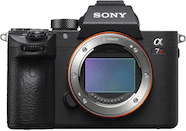The Sony Alpha a7R III is a high-resolution, full-frame mirrorless camera, an update to the a7R II, and the predecessor to the a7R IIIA and a7R IV. Key features include:
Very high resolution and excellent low-light performance
Five-axis image stabilization
Updated hybrid autofocus system
4K video capture
What’s Changed? The Sony Alpha a7R III offers several improvements over its predecessor, the a7R II. It boasts a faster processor, a redesigned shutter, improved autofocus performance, a higher-resolution electronic viewfinder, dual SD slots, and a higher-capacity battery.
42.4MP CMOS Sensor and BIONZ X Image Processor. The Sony Alpha a7R III’s 42.4MP back-illuminated full-frame Exmor R BSI CMOS sensor works in tandem with the BIONZ X processor to deliver incredibly fast performance, excellent image quality, and great low-light performance. You get 14-bit RAW 42.4MP stills with a native sensitivity range of ISO 100-32000, which can be expanded to ISO 50-102400. You also get internal UHD 4K video capture using the sensor’s full width. This combination of sensor and processor enables the a7RIII to keep up with fast-paced shooting applications. You can shoot up to 10 fps at full resolution with full autofocus for up to 76 consecutive frames in either mechanical or electronic shutter mode, and up to 8 fps in live-view mode. If this still isn’t enough, check out the Sony Alpha a7R IV, featuring a 61MP rear-illuminated CMOS sensor.
Improved Hybrid Autofocus System. This updated 4D FOCUS autofocus system gives you twice the speed and substantially more reliable tracking compared to previous a7R cameras. It features 399 on-sensor phase-detect autofocus points with 68% coverage along with 425 contrast-detect autofocus points, providing extremely fast, accurate performance. You have the option of Flexible Spot focusing, which uses neighboring focus points to stay focused on fast-moving subjects even if the original point loses focus. The Eye AF feature lets you base focusing on a familiar subject’s eyes, making this camera great for portraiture, while Focus Magnification emphasizes minute details. The a7R III sees the addition of an AF Point joystick and dedicated AF On button, in addition to touchscreen control.
Five-Axis SteadyShot INSIDE Image Stabilization. Borrowed from the a9, the SteadyShot INSIDE image-stabilization system offers up to five stops of correction on to any lens you mount. This system compensates for five types of camera shake, including angular shake (pitch and yaw), shift shake (X and Y axes), and rotational shake (roll). All five stabilization axes are constantly engaged, even when you’re using third-party lenses, adapters, or lenses with their own built-in image stabilization.
UHD 4K Video Capture. The a7R III can capture UHD 4K video in multiple frame rates up to 30 fps, which is oversampled 2.4-fold from 5K footage to ensure that there’s no pixel-binning or line skipping. It can also capture Full HD 1080p at up to 120 fps. Both 4K and Full HD resolutions use 100 Mbps XAVC S format in an MP4 wrapper with 4:2:0 sampling. In addition to these high-resolution internal-recording options, the a7R III offers uncompressed 4:2:2 video output via an HDMI connection. You can store a frame grab from a 4K recording as an 8MP still.
Pixel Shift Multi-Shooting Mode. New to the a7R III is a Pixel-Shift Multi-Shooting mode that shoots four images and moves the sensor between each shot in order to capture full color information for every pixel. This reduces noise and softens the image in a fashion similar to demosaicing. There are a couple of downsides to this feature, though. Firstly, the a7R III can’t assemble the final images on its own, so you must use the Sony Imaging software suite to process the four RAW images. Secondly, it takes the camera between one and thirty seconds between each shot, meaning there’s a high chance your subject will move between the first and fourth shot.
Other Notable Features. There’s an NTSC/PAL-switchable Slow and Quick Motion mode, an enhanced Zebra function to help you monitor exposure values in high-contrast scenes, a Time Code feature that makes editing easier, hot-shoe and PC-terminal external-flash connections, automatic anti-flicker shutter timing, an advanced metering system, a range of Creative Style modes, and built-in Wi-Fi and Bluetooth capabilities for wireless image sharing and camera control. It records its 14-bit RAW images, JPEGs, and video files to SD memory cards via its dual SD memory card slots (one of which is UHS-II compatible), and uses the rechargeable NP-FZ100 battery that’s rated for 530 shots per charge when you’re using the viewfinder or 650 shots with the rear LCD.



















